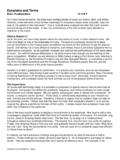Transcription of SOLID MECHANICS DYNAMICS TUTORIAL – …
1 SOLID MECHANICS DYNAMICS TUTORIAL centripetal force This work covers elements of the syllabus for the Engineering Council Exam D225 DYNAMICS of Mechanical Systems C103 Engineering Science. This TUTORIAL examines the relationship between inertia and acceleration. On completion of this TUTORIAL you should be able to Explain and define centripetal and centrifugal acceleration. Explain and define centripetal and centrifugal force . Solve problems involving centripetal and centrifugal force . Derive formulae for the stress and strain induced in rotating bodies. Solve problems involving stress and strain in rotating bodies. Analyse problems involving vehicles skidding and overturning on bends.
2 It is assumed that the student is already familiar with the following concepts. Newton s laws of Motion. Coulomb s laws of friction. Stiffness of a spring. The laws relating angular displacement, velocity and acceleration. The laws relating angular and linear motion. Basic vector theory. Basic stress and strain relationships. All the above may be found in the pre-requisite tutorials . 1. centripetal AFFECTS ACCELERATION AND force centripetal acceleration occurs with all rotating bodies. Consider a point P rotating about a centre O with constant angular velocity (fig. 1). Figure 1 The radius is the length of the line O-P. The tangential velocity of P is v = R.
3 This velocity is constant in magnitude but is continually changing direction. Let s remind ourselves of the definition of acceleration. t va takentimeyin velocit changea== Velocity is a vector quantity and a change in direction alone is sufficient to produce a change. It follows that a point travelling in a circle is continuously changing its direction, velocity and hence has acceleration. Next let s remind ourselves of Newton s second Law of Motion which in its simplest form states force = Mass x acceleration. It follows that anything with mass travelling in a circle must require a force to produce the acceleration just described. The force required to make a body travel in a circular path is called centripetal force and it always pulls towards the centre of rotation.
4 You can easily demonstrate this for yourself by whirling a small mass around on a piece of string. Let s remind ourselves of Newton s Third Law. Every force has an equal and opposite reaction. The opposite and equal force of centripetal is the CENTRIFUGAL force . The string is in tension and this means it pulls in both directions. The force pulling the ball towards the middle is the centripetal force and the force pulling on your finger is the centrifugal force . The derivation of the formula for centripetal force and acceleration is done by considering the velocity as a vector. Figure 2 Consider the velocity vector before and after point P has revolved a small angle.
5 The magnitude of v1 and v2 are equal so let s denote it simply as v. The direction changes over a small period of time t by radians. We may deduce the change by using the vector addition rule. The first vector + the change = Final vector. Figure 3 The rule is v1 + v = v2. This is illustrated below. Figure 4 v is almost the length of an arc of radius v. If the angle is small, this becomes truer. The length of an arc is radius x angle so it follows that v = v This change takes place in a corresponding small time t so the rate of change of velocity is t v t v = In the limit as t dt, v/ t dtdv t v dt, t dtdv is the dtd vdtdva=== angle of change of rate dtd == Since v = R then substitute for v and a = 2R and this is the centripetal acceleration.
6 centripetal acceleration = 2R Since = v/R then substitute for and a = v2/R centripetal acceleration = v2/R If we examine the vector diagram, we see that as becomes smaller and smaller, so the direction of v becomes radial and inwards. The acceleration is in the direction of the change in velocity and so centripetal acceleration is radial and inwards. If point P has a mass M, then the force required to accelerate this mass radial inwards is found from Newton's 2nd Law. centripetal force = M 2 R or in terms of velocity v centripetal force = M v2/R Centrifugal force is the reaction force and acts radial outwards. WORKED EXAMPLE Calculate the centripetal acceleration and force acting on an aeroplane of mass 1500 kg turning on a circle 400 m radius at a velocity of 300 m/s.
7 SOLUTION centripetal acceleration = v2/R = 3002/400 = 225 m/s2. centripetal force = mass x acceleration = 1500 x 225 = kN WORKED EXAMPLE Calculate the centripetal force acting on a small mass of kg rotating at 1500 rev/minute on a radius of 300 mm. SOLUTION = 2 N/60 = 2 x x 1500/60 = 157 rad/s Cent. acc. = 2R = (157)2 x = 7395 m/s2. Cent. force = Mass x acc. = x 7395 = 3697 N WORKED EXAMPLE A centrifugal clutch is shown in the diagram. The clutch must transmit a torque of 18 Nm at a speed of 142 rev/min. The coefficient of friction between the drum and the friction lining is The radius to the centre of gravity of each sliding head is m and the inside radius of the drum is m.
8 Calculate the required mass of the sliding heads. Figure SOLUTION Torque = 18 Nm, radius = m T = Friction force x radius Friction force = 18 = 72 N This is divided between two friction pads so each must produce 72/2 = 36 N each. From the law of friction, Friction force = x normal force Normal force = 36 = 120 N The normal force acts in a radial direction and must be equal to the centripetal force . centripetal force = M 2r Equating forces we have M 2r = 120 Speed = 142 rev/min or 142/60 rev/s Radius to centre of gravity = m Angular velocity = 2 x speed = 2 x 142/60 = rad/s M x =120 M = 120/( ) = kg for each sliding head.
9 SELF ASSESSMENT EXERCISE 1. A centrifugal clutch is similar to that shown in figure 5. The clutch must transmit a torque of 25 Nm. The coefficient of friction between the drum and the friction lining is Each sliding head has a mass of kg acting at a radius of m. The inside radius of the drum is m. Calculate the minimum speed required. (Answer rad/s or rev/min) 2. A rotating arm has a sliding mass of 2 kg that normally rests in the position shown with the spring uncompressed. The mass is flung outwards as it revolves. Calculate the stiffness of the spring such that the mass compresses it by 20 mm when the arm revolves at 500 rev/min.
10 (Answer N/mm) Figure 6 2 STRESS and STRAIN in ROTATING BODIES STRESS Wheels experience stresses in them because the centripetal reaction (centrifugal force ) tends to stretch the material along a radius. This can cause the wheel to disintegrate if it runs to fast. The effect might be catastrophic in a grinding wheel or flywheel. Even if the wheel does not disintegrate, the stress will cause it to expand. The blades on a turbine or compressor rotor will stretch slightly under this strain and might touch the casing. Consider a bar of uniform cross section A rotating about its centre as shown. Figure 7 The radius to the tip is R. Consider a small length r at radius r.














